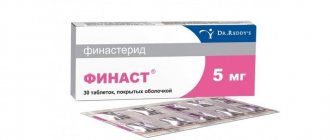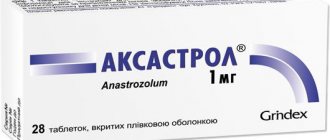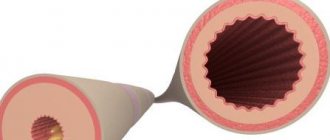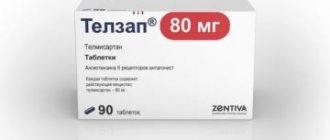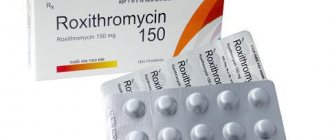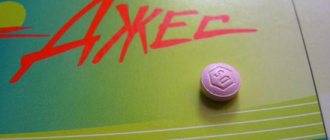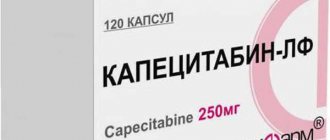Stock
these words:
ibuprofen, p-piperidinoetoxy-o-carbomethoxybenzophenone hydrochloride, alpha-piperidinoetyldiphenylacetamide methobromide;
1 tablet, sealed with a spit shell, containing ibuprofen 400 mg, p-piperidinoetoxy-o-carbomethoxybenzophenone hydrochloride 5 mg, alpha-piperidinoetyldiphenylacetamide methobromide 0.1 mg;
additional speeches:
microcrystalline cellulose, corn starch, glycerin, anhydrous silica dioxide, talc, magnesium stearate, hypromelose, polyethylene glycol, titanium dioxide (E 171), polysorbate-80, sorbic acid, dimethicone .
Varieties and composition
The medicine is made in the form of film-coated tablets. The active elements of the drug “Novigan”, from which it helps against pain of various origins, are:
- Phenpiverinium bromide.
- Ibuprofen.
- Pitophenone hydrochloride.
Auxiliary components are: starch, talc, silicon dioxide, glycerol.
Novigan tablets are packaged in blister packs of 10 pieces. The cardboard pack contains 1 or 2 blisters with tablets, as well as instructions for use of the drug.
Pharmacological authorities
Pharmacodynamics.
Novigan® is a combination drug that belongs to the group of analgesic and antispasmodic agents. The drug stock includes: ibuprofen - non-steroidal anti-inflammatory drug (NSAID), p-piperidinoetoxy-o-carbomethoxybenzophenone hydrochloride - myotropic antispasmodic drug and alpha-piperidinoyldiphenylacetamide methobromide - anticholinergic and capture the central and peripheral action.
The main mechanism of pharmacological action of ibuprofen lies in the inhibition of prostaglandin synthesis. Non-selective non-steroidal anti-inflammatory agents, which include ibuprofen, act as systemic inhibitors (peripheral and central) of the synthesis of prostaglandin G/H enzymes, also known as cyclooxygenase-1 (COX-1) and cyclooxygenase-1. 2 (TsOG-2). These enzymes are responsible for the transformation of arachidonic acid on various tissue-specific prostaglandins and thromboxanes. COX-1 is constitutively expressed in all tissues and is responsible for the production of prostaglandins, which support the functioning of organs, protect the integrity of the mucous membrane, and generate thromboxin, which is responsible for for platelet aggregation and vasoconstriction. When ignited, COX-2 is induced, which produces prostaglandins that mediate ignition processes.
P-piperidinoetoxy-o-carbomethoxybenzophenone hydrochloride has a direct myotropic effect on the smooth tissue of internal organs. Inhibits phosphodiesterase, reduces the accumulation of cAMP and decreases calcium in the cell, weakens the smooth muscles of the vessels and internal organs.
Alpha-peridinoyldiphenylacetamide metobromide, for its effect on the ganglion blocking and parasympathetic action, reduces the tone and motility of the smooth muscles of the vulva, intestines, ruminants and glands.
Pharmacokinetics.
Ibuprofen is readily absorbed in the intestinal tract when taken orally. The maximum concentration in blood plasma is determined 1-2 years after stagnation. About 99% of ibuprofen is bound to plasma proteins. It is important to be excreted either in the unchanged form or in the form of oxidized inactive metabolites. Completely excreted from the body within 24 years.
The addition of three components to the drug mutually enhances their pharmacological action, resulting in pain relief, relaxation of smooth muscles, and a decrease in elevated body temperature.
Who should take it?
Novigan is used as an anti-inflammatory, antispasmodic and antipyretic medicine in women.
Dysmenorrhea occurs, according to various sources, in 60 - 70% of girls. Moreover, sometimes the fact of pain during menstruation is often taken as the norm, since all women in the family may have it. Novigan is suitable for the treatment of both primary and secondary dysmenorrhea.
They can also stop attacks of pain in the lower abdomen on the eve of menstruation.
If you experience discomfort in the middle of the cycle due to ovulation, you can use this drug.
Caution should be exercised in the following conditions:
- If the pain is unusual, more intense, and localized in an atypical location.
- If there is much more discharge, you can even say that it is bleeding.
- If you suspect an acute abdominal pathology, for example, appendicitis, etc. There is severe bloating and other symptoms.
- If the pain is accompanied by severe nausea, vomiting, diarrhea.
Showing
Mild or moderate expressions of pain syndrome due to spasms of smooth muscles of internal organs - nircova or hepatic colic, dyskinesia of the uterus, intestinal spasms, spastic dysmenorrhea and other spastic conditions of internal smooth muscles external organs. Headache, including migraine in nature. Briefly symptomatic pain in the joints, neuralgia, ischialgia, myalgia. To reduce elevated body temperature during colds and infectious-inflammatory illnesses.
conclusions
Novigan is a modern and effective drug for the relief of painful sensations that occur, including dysmenorrhea. The medicine helps to relax the smooth muscles of the organs, which leads to the relief of pain and spasms. Its effectiveness is due to the combination of three analgesic and antispasmodic components included in the composition. Their harmonious combination with each other leaves no chance for pain.
We have reviewed the instructions, reviews, price and analogues for the Novigan product.
Contraindicated
- Individual sensitivity to the components of the drug and to other non-steroidal anti-inflammatory drugs has been increased.
- Hypersensitivity reactions (such as bronchial asthma, rhinitis, angioedema, or urticaria), which were previously observed after administration of ibuprofen, acetylsalicylic acid (aspirin) or other NSAIDs ZZ.
- Novigan® is contraindicated in patients who have a history of erosive-virulent lesions of the scutulo-intestinal tract, scutulo-intestinal hemorrhage or perforation after stasis of NSAIDs.
- Severe dysfunction of the liver and heart failure.
- The disadvantage of taking ibuprofen, especially at high doses, along with other non-steroidal anti-inflammatory drugs, including selective cyclooxygenase-2 inhibitors, is due to the possibility of additive effects and the development of side reactions heart, stroke.
- The drug is also contraindicated for hepatic porphyria, spasmodic deficiency of glucose-6-phosphate dehydrogenase, tachyarrhythmia, damage to the visual nerve, damaged hematopoietic or laryngeal blood flow, sick blood, closed cuta and glaucoma, heart failure, hypertrophy of the anterior aneurysm, mechanical obstruction of the scili-intestinal tract or megacolon.
- Cerebrovascular or other bleeding.
- Severe dehydration.
- The remaining trimester of pregnancy and breastfeeding period.
- Children's age until the 16th century.
Interactions of the drug Novigan
Concomitant use of Novigan with other NSAIDs or non-narcotic analgesics may lead to increased toxic effects. The drug can increase the concentration of digoxin in the blood plasma, potentiate the effect of insulin and oral hypoglycemic drugs, increase the toxicity of colchicine, gold and lithium preparations, methotrexate, probenecid. May reduce the diuretic, natriuretic and antihypertensive effects of diuretics and reduce the effectiveness of many antihypertensive drugs.
Interactions with other medicinal drugs and other types of interactions
Simultaneous administration of the drug Novigan® with other non-steroidal drugs (NSAIDs) or non-narcotic analgesics can lead to a further increase in toxic effects.
A trace of the uniqueness of one-hour administration of the drug Novigan® in a combination with offensive drugs:
Acetylsalicylic acid:
Immediate administration of ibuprofen and acetylsalicylic acid is strictly not recommended due to the potential for increased side effects. There are data that suggest that ibuprofen can competitively inhibit the infusion of low doses of acetylsalicylic acid on platelet aggregation when they are stagnated for one hour. Also, it is possible to change the cardioprotective effect when taking low doses of acetylsalicylic acid when taking ibuprofen.
Use caution when using Novigan® in combination with offensive drugs:
Anticoagulant:
NSAIDs may interfere with the effects of anticoagulants such as warfarin.
Antihypertensive drugs (ACE inhibitors and angiotensin II antagonists) and diuretics:
NSAIDs may alter the therapeutic effect of these drugs. In some patients with impaired nirofunction (for example, in winter patients or in summer patients with weakened nirofunction), immediate administration of an ACE inhibitor or an angiotensin-converting enzyme antagonist Iotensin II and drugs that inhibit cyclooxygenase may lead to further impairment of nirconia function, including possible acute nicotine deficiency , scho zavichay has a werewolf character. Therefore, such combinations should be used with caution, especially for summer age patients. If it is necessary to properly hydrate the patient, adequately hydrate the patient and monitor the function of the skin on the surface of the combined treatment, as well as at regular intervals thereafter.
Diuretics may increase the risk of nephrotoxic influx of NSAIDs.
Corticosteroids:
movement rhizik resolves and bleeds in the scolio-intestinal tract.
Antiplatelet properties and selective inhibitors of serotonin secretion:
movement risk and splancholar-intestinal bleeding.
Cardiac glycosides
– with one-hour treatment with NPZD there may be acute cardiac failure, a decrease in glomerular filtration fluidity and an increase in the concentration of cardiac glycosides in blood plasma.
Medicines for the summer
– with one-hour stagnation, the elimination of drugs during the summer decreases and their toxicity and concentration in blood plasma increases.
Methotrexate
– with one-hour stagnation, the elimination of methotrexate decreases and its toxicity and concentration in blood plasma increases.
Cyclosporine
– with one-hour stagnation with NSAIDs, nephrotoxicity develops.
Mifepristone
– the use of NSAIDs is allowed only 8-12 days after discontinuation of mifepristone, since the NSAIDs reduce the effect of mifepristone.
Antibiotics of the quinolone series
– NSAIDs may precipitate the risk of convulsions associated with quinolone use.
Zidovudine
– There is evidence of an increased risk of hemarthrosis and hematomas in HIV-infected patients, as a result of concomitant treatment with zidovudine and ibuprofen.
Tacrolimus
– the risk of nephrotoxicity is increasing with one-hour ingestion of NSAIDs with tacrolimus.
Roslinny drug Ginkgo biloba
may potentiate the risk of bleeding when taking non-steroidal anti-inflammatory drugs.
Features of good stagnation
With care and under the supervision of a physician, the drug should be used for the treatment of patients with severely impaired liver function, or in cases of susceptibility to arterial hypertension, bronchospasm, and systemic liver disease. systemic diseases of the tissue - advanced rhiziquosis and aseptic meningitis; a history of heart failure, which was accompanied by blockage in the home and swelling during the period of stagnation of non-steroidal anti-inflammatory drugs.
Flowing into the cardiac-vascular and cerebrovascular system.
Clinical and epidemiological data indicate that ibuprofen administration, especially at high doses (2400 mg per dose), and that prolonged administration may lead to a slight increase in the risk of arterial thrombus typical complications (for example, myocardial infarction or stroke). However, epidemiological data do not suggest that low doses of ibuprofen (eg, ≤ 1200 mg per dose) may increase the risk of myocardial infarction. Patients with uncontrolled arterial hypertension, congestive heart failure, diagnosed with ischemic heart disease, diseases of the peripheral arteries and/or long-term cerebrovascular disease Kuvanna can be prescribed by a doctor only after a physical analysis. Patients with significant risk factors for cardiovascular complications (such as arterial hypertension, hyperlipidemia, diabetic diabetes, chicken) should exercise caution and consult with a doctor before taking the drug. How many times when taking NSAIDs were there reports of congestion, hypertension and swelling.
Vpliv na organi dikhannya.
Bronchospasm may occur in patients who suffer from bronchial asthma or allergic illness, or who have a history of illness.
Other oil refineries.
The difference between one-hour administration of ibuprofen and other NSAIDs, including selective cyclooxygenase-2 inhibitors, increases the risk of adverse reactions.
Floating on the nirk.
The risk of nicotine deficiency is associated with impaired nicotine function: prolonged use of NSAIDs can lead to a long-term decrease in the synthesis of prostaglandins and provoke the development of nicotine deficiency. High risk of this reaction in patients with impaired liver function, cardiac dysfunction, impaired liver function, in patients taking diuretics, and in patients with summer century In such patients, it is necessary to monitor the neuronal function. Patients at the stage of dehydration may experience a risk of impaired function.
Impact on fertility in women.
It is clear that medications that inhibit cyclooxygenase/prostaglandin synthesis may interfere with the ovulation process. This process is reversed after the administration of the bath. Long-term stagnation (a dose of 2400 mg over a period of time, as well as a three-day bath for 10 days) and Buprofen can impair a woman’s fertility and is not recommended for women who are susceptible to pregnancy. Women who have difficulty with pregnancy or are under stress due to infertility should take this drug.
Floods into the scolio-intestinal tract.
NPZZ should be careful in patients with chronic inflammation of the intestines (viral colitis, Crohn's disease), fragments of the intestine may become inflamed. There is information about types of intestinal hemorrhage, perforation, and leaks, which can be fatal, that occurred at any stage of the treatment of NSAIDs, regardless of the presence of pre-masticatory symptoms or the appearance history of severe disorders on the side of the scolio-intestinal tract.
Increasing the dose of NSAIDs, summer age and a history of viral disease carries a risk of adverse reactions in the herbal tract. During treatment in such cases, it is recommended to take the minimum effective dose of the drug.
Use caution when administering the drug to patients undergoing medication therapy that may increase the risk of varicose vein disease of the vulva and duodenum or bleeding, using oral corticosteroids. Foods such as anticoagulants such as warfarin, selective serotonin secretion inhibitors or antiplatelet agents such as acetylsalicylic acid . Patients who have suffered from scutulo-intestinal disorders, especially those of summer age, should undergo treatment and consult a doctor if any unusual symptoms appear (especially bleeding from the herbal tract).
On the side of the skin and under the skin.
Even rarely, aphids ingested NSAIDs can cause severe forms of skin reactions that can be fatal, including exfoliative dermatitis, Stevens-Johnson syndrome, and toxic epidermal necrolysis. The greatest risk of the appearance of such reactions is avoided in the early stages of therapy; in most cases, the beginnings of such reactions appear during the first month of treatment. Cases of acute generalized exanthematous pustulosis (AGEP) have been reported due to the stagnation of drugs that can be stored in ibuprofen.
Novigan should be taken and immediately referred to the doctor at the first signs of skin rash, the appearance of puffiness on the skin, pathological changes in the mucous membranes, or any other signs of hypersensitivity, fragments of this These may be the first signs of a serious, selfish reaction.
If you do not take the drug in case of chickenpox, some concomitant use of NSAIDs may prevent you from getting sick. NPZD can cause the development of problems such as serious infections of the skin and soft tissues.
In case of trival (or more severe) stagnation of the drug, it is necessary to monitor peripheral blood indicators and the functional state of the liver.
The drug can affect the psychophysiological state of patients when taken simultaneously with alcohol and in ways that depress the central nervous system.
Trival and uncontrolled use of pain-relieving drugs, especially the consumption of certain pain-relieving drugs, can lead to a chronic level of neurosis with the risk of nicotine deficiency (analgesic nephropathy).
The drug should not be used in cases of acute intolerance to galactose or dairy products or lactase deficiency.
As with other NSAIDs, taking ibuprofen may mask the signs of infection.
Special instructions for the use of the drug Novigan
Novigan is intended for episodic or short-term treatment (up to 5 days). The drug should be used with caution under the supervision of a physician in case of impaired liver or kidney function, with a tendency to hypotension, bronchospasm, as well as with increased individual sensitivity to NSAIDs or non-narcotic analgesics. With long-term (7 days) use of the drug, it is necessary to monitor peripheral blood parameters and the functional state of the liver. The drug can affect the psychophysiological state of the patient when taken simultaneously with alcohol and central nervous system depressants. When using the drug, care must be taken when driving vehicles and/or operating other mechanisms.
Suspension during pregnancy or breastfeeding
Inhibition of the synthesis of prostaglandins can negatively affect the gestation and/or development of the embryo/fetus. Data from epidemiological studies indicate increased risk of pregnancy after stagnation of inhibitors of prostaglandin synthesis in the early stages of pregnancy. It is important that the risk progresses with increasing doses and severity of therapy. During the 1st and 2nd trimesters of pregnancy, the drug begins to wear off.
At the beginning of the third trimester of pregnancy, when any inhibitors of prostaglandin synthesis are stagnant, such effects may occur on the fetus as cardiac-legeneva toxicity (preventive closure of the arterial ducts of the fetus with fetal hypertension) and damage functions of nirok, which can progress to nirconic deficiency with the manifestation of oligohydroamnion.
Ibuprofen is contraindicated in the third trimester of gestation due to the possibility of suppressing the sensory function of the uterus, which can lead to increased pregnancy loss with a tendency to increased bleeding in the mother and child, apparently when administering low doses.
During the period of treatment, the breast should be treated with the drug slid.
Method of congestion and dosage
Maintain the lowest effective dose needed to relieve symptoms over the shortest period of time. If symptoms persist for more than 5 days, before treatment or worsening, they may need to be referred to a doctor.
Novigan® must be completely cured either 1 year before or 3 years after. The tablets should be washed down with water and should not be dissolved. To prevent diarrheal action on the mucous membrane, sterilize it immediately after eating or drink it with milk.
It is recommended to take the drug 1 tablet up to 3 times per dose. The maximum recommended dosage is 3 tablets.
Repeat the dose once consumed every 4-6 years. Do not exceed the dose of 1200 mg ibuprofen per dose.
Individuals of the summer age do not require special dosing.
Therapeutic properties
Novigan tablets, which are why they are popular among many patients, have antispasmodic, analgesic and anti-inflammatory effects. The presence of ibuprofen in its composition determines the properties of the medication. The medicine also allows you to reduce elevated body temperature, thus creating an antipyretic effect.
The mechanism of action of the drug is based on slowing down the reproduction of prostaglandins, which are responsible for pain, heat exchange in the body, and inflammation processes. The antispasmodic effect is provided by pitofenone hydrochloride and fenpiverinium bromide. The first active substance relaxes the muscles of the internal organs, the second enhances this effect.
Overdose
Symptoms
. Manifests itself in the form of bowel-intestinal disorders (diarrhea, nausea, vomiting, anorexia, epigastric pain), manifesting hepatotoxicity, impaired fluidity.
Other causes include noise in the ears, headache, and intestinal bleeding. In severe cases, there is a toxic effect on the central nervous system, which manifests itself as drowsiness, restlessness, disorientation, or coma. In some cases, patients develop seizures. In more severe cases, metabolic acidosis and an increase in prothrombin hour/MNB may occur (probably through interactions with laryngeal factors that circulate in the bloodstream). It may be due to the lack of nirk and the damage to the liver. Patients with bronchial asthma may be careful not to overextend their asthma.
Likuvannya.
Symptomatic and supportive therapy is indicated, including ensuring the patency of the respiratory tract and monitoring cardiac function and basic indicators of vitality until the patient’s condition normalizes. Longer life after taking a large dose, it is recommended to wash out the scutum and take activated vugill. It is necessary to ensure proper monitoring and control of liver function. After taking potentially toxic doses, patients should be careful for at least 4 years. In cases of convulsions, diazepam or lorazepam can be administered internally. In cases of bronchial asthma, bronchodilators may be used.
Side effects
There are reviews of Novigan, which causes allergies, renal dysfunction, proteinuria, oliguria, anuria, nephritis, dry mouth, tachycardia, urinary retention, paresis, accommodation.
After using Novigan, red coloration of urine is also noted.
When taking high doses of the drug, nausea, abdominal pain, vomiting occur, and vision is impaired. To treat intoxication, the stomach is washed, an adsorbent is taken, and standard symptomatic treatment is carried out.
Side effects
The incidence of adverse reactions can be minimized by maintaining the lowest effective doses of the drug.
Occurrence of adverse reactions was observed with short-term administration of ibuprofen at doses that did not exceed 1200 mg/dose. In case of treatment of chronic illnesses and in cases of severe ingestion, other side reactions may occur.
Adverse reactions associated with ibuprofen administration are classified according to organ systems and frequency. Frequency is indicated by the following order: very often: ≥1/10; often: ≥1/100 and <1/10; uncommon: ≥1/1000 and <1/100; rare: ≥1/10000 and <1/1000; very rare: <1/10000, frequency unknown (it is impossible to estimate the frequency from obvious data).
On the side of the scolio-intestinal tract.
Possible – abdominal pain, dyspepsia, boredom.
Rarely – diarrhea, flatulence, constipation, vomiting.
Very rarely - peptic ulcers, perforation or intestinal hemorrhage, swelling, melena, crooked vomiting (sometimes lethal), virulent stomatitis, acute virulent colitis and Crohn's disease, gastritis, esophagitis.
On the side are the blood and lymphatic systems.
Very rarely: disruption of hematopoiesis1.
1 Includes anemia, leukopenia, thrombocytopenia, pancytopenia and agranulocytosis. The first signs of such damage are shortness of breath, sore throat, superficial ulcers in the mouth, flu-like symptoms, a severe form of congestion, bleeding and hematomas of unknown etiology.
On the side of the cardiovascular system.
Rarely: tachycardia, dyspnea, cerebrovascular complication, arterial hypotension, heart failure.
Very rarely: swelling, arterial hypertension, heart failure.
With long-term stasis, high doses (2400 mg/dose) may increase the risk of arterial thrombotic complications (for example, stroke or myocardial infarction), and reduce the effectiveness of antihypertensive agents.
Zagalni discord.
Very rarely: non-specific allergic reactions and anaphylactic shock, asthma or worsening asthma, bronchospasm, swelling, itching, urticaria, purpura, angioedema.
On the side of the nervous system.
Uncommon: headache.
Very rare: neuritis of the visual nerve, paresthesia, nervousness, confusion, drowsiness, twitchiness, ringing in the ears, depression, insomnia, anxiety, psychomotor restlessness, emotional instability, seizures. Frequency unknown: hallucinations, confusion.
On the side of the immune system.
Uncommon: hypersensitivity reactions, which are accompanied by kropivyanka and itching2. Very rarely: severe hypersensitivity reactions, symptoms of which may include swelling of the face, tongue and larynx, palpitation, tachycardia, arterial hypotension (anaphylaxis, angioedema, or severe shock).
2 The hypersensitivity reaction may include: (a) nonspecific allergic reactions and anaphylaxis, (b) reactivity of respiratory disorders, including asthma, exacerbation of asthma, bronchospasm and airway, or (c) and forms of skin reactions, including itching, urticaria, purpura, angioedema, and also exfoliative and bullous dermatoses, including toxic epidermal necrolysis, Stevens-Johnson syndrome and erythema multiforme.
In patients with systemic worms and mixed diseases, the use of ibuprofen in the affected tissue, in some cases, can lead to the appearance of symptoms of aseptic meningitis, and itself – stiffness of the urinary ulcers, headache, vomiting, high blood pressure temperature or disorientation.
On the side of the organs are the hematopoietic and lymphatic systems.
Very rarely: disorders of the hematopoietic system (hemolytic anemia, aplastic anemia, thrombocytopenia, neutropenia, eosinophilia, decreased hematocrit and hemoglobin level, pancytopenia, agranulocytosis). The first signs are high temperature, sore throat, swollen mouth, flu symptoms, severe fever, unexplained bleeding and blue. Reversible platelet aggregation, alveolitis, lehenevian eosinophilia.
From the side of the organs.
Very rarely: blurred vision, change in color perception, toxic amblyopia. Frequency unknown: destruction of vision.
On the side of the hepatobiliary system.
Very rarely: impaired liver function, hepatitis, hepatitis, duodenitis, pancreatitis, hepato-renal syndrome, liver failure, hepatonecrosis.
On the side of the skin and under the skin.
Rarely: peeling of the skin, alopecia, photosensitivity, various sagging skin. Very rarely: bullous infections, including Stevens-Johnson syndrome, erythema multiforme, toxic epidermal necrolysis. The frequency is unknown - a drug-induced skin reaction, which is accompanied by eosinophilia and systemic manifestations (DRESS), infections of the skin and soft tissues (in case of varicose veins, complications may arise due to the flu and as important infections of the skin and soft tissues), acute generalization of exanthematous pustulosis (AGEP). With the appearance of a red, luscious pink visip with hardened under the skin and puffiness, localized especially at the skin folds, on the torso and upper ends, which is accompanied by fever on the ear of the skin, a trace of stop stagnating with the doctor and urgently go to the doctor, these signs may be manifestations of acute generalized exanthematous pustulosis (division “Peculiarities of congestion”).
On the side there is a sternoid system.
Very rare: papilonecrosis, cystitis, hematuria, nephrotic syndrome, oliguria, polyuria, tubular necrosis, glomerulonephritis, impaired function of the liver, toxic nephropathy in various forms, including interstitial nephritis, nephrotic syndrome that nirk insufficiency, the destruction of the nirk function.3
3 Especially with long-term stagnation of the NPZD, in the blood serum and the appearance of swellings. Also includes papilonecrosis.
Other effects.
Rarely: dryness of the mucous membranes of the eyes and mouth, stomatitis, high temperature, poor self-esteem, weakness, increased fatigue, hearing loss, virulent stomatitis.
Very rarely: changes in the endocrine system and metabolism, changes in appetite.
Laboratory research.
Very rarely: decreased hemoglobin level.
